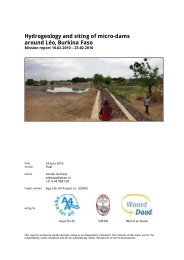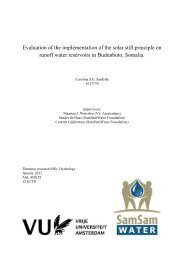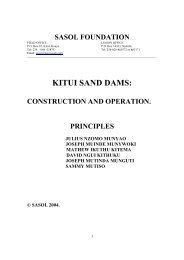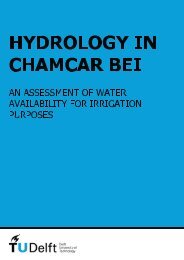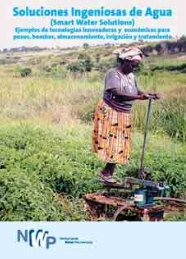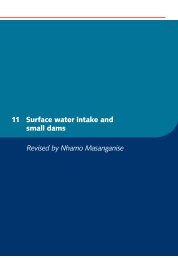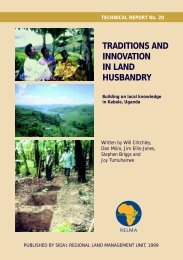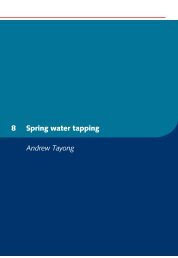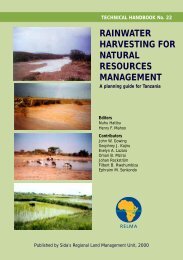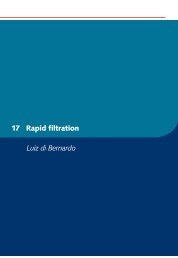2.4 <strong>Water</strong> requirementsTo estimate how much water is required and for how long, some simple calculationsare required. The demand for water for domestic purposes, livestock and irrigationcan be estimated as shown below.In this case we assume that the stored water will be needed for a dry season of 180days in an ASAL region, although this figure will vary in different localities. Thefollowing tables are examples of water use based on a family of 8 people, with 2 milkcows, 10 Zebu cattle, 14 sheep, 10 goats, 3 pigs and ¼ acre of land under dripirrigation.In practice, to determine the water requirement for any particular household, orcommunity, information on the number of people, livestock and any irrigationrequirements need to be gathered. In many cases, due to the availability of betterquality alternative water sources for domestic consumption <strong>from</strong> a hand-dug well, orrainwater tank, water <strong>from</strong> a dam or pond will only be required for livestock2.4.1 <strong>Water</strong> for domestic useIn this example, the daily water use of a typical African household in a semi-aridlocation is taken as 14 litres/person/day, which is equivalent to 112 litres for ahousehold of eight, or half an oil drum of water for each day. This volume is muchhigher than the actual 5 litres/person/day, commonly used for drinking and cooking inASAL regions.Table 1.NumberpersonsExample of water needed for a household in ASALof DailyNumber of Total waterconsumption per days without requirementpersonrain8 x 14 litres x 180 days = 20,160 litres2.4.2 <strong>Water</strong> for livestockThe amount of water required by livestock will vary greatly depending on the season,temperature, moisture content of animal forage and type of animals. Table 2 showsthe dry season requirements for various common types of livestock.Table 2. Example of water requirements for livestock in ASALType and DailyNumber of days Total waternumber of consumption per without rain requirementlivestock animalMilk cows 2 x 50 litres x 180 days = 18,000 litresZebu cows 10 x 27 litres x 180 days = 48,600 litresSheep 14 x 5 litres x 180 days = 12,600 litresGoats 10 x 3 litres x 180 days = 5,400 litresPigs 3 x 10 litres x 180 days = 5,400 litresTotal requirement for watering livestock = 90,000 litresSource of data: Rain Catchment and <strong>Water</strong> Supply in Rural Africa, Nissen-Petersen, E. 1982& Finkel and Segerros 1995 (RELMA Technical Handbook No. 22).2.4.3 <strong>Water</strong> for irrigation8
It is difficult to estimate the water requirement for irrigation because it depends on thetype of irrigation method used, the soil type, climate, crop type and its growingperiod. For example, bucket irrigation of vegetables requires about double the volumeof water required for drip irrigation. Table 3 illustrates the water requirement fortomato/kale production using drip irrigation on a 1/4 acre.Table 3. Example of water requirements for drip irrigationType of Type of crop Daily <strong>Water</strong> Total waterirrigationrequirementfor 90 dayson a ¼ acre(approx. 1000 m 2 )requirementDrip irrigation Tomatoes/kale 1,000 x 90 = 90,000 litresTotal requirements for drip irrigation of 1/4 acre is 90,000 litresSource: Drip Irrigation Project, Kenya Agricultural Research Institute (KARI).2.4.4 Total water requirementA reasonable estimate of the water demand that a pond or small earth dam may beexpected to meet can now be worked out by simply adding together the total waterrequirements for domestic, livestock and irrigation in tables 1, 2 and 3.Table 4. Example of total water requirement for domestic, livestock andirrigationDomestic water for a household for 180 days20, 160 litres<strong>Water</strong>ing 35 animals for 180 days90,000 litresDrip irrigation of 1/4 acre for one growing season90,000 litresTotal water requirement200,160 litresThe total water requirement is estimated as 200,160 litres which can be converted intocubic metres by dividing the figure by 1,000 as follows; 200,160 litres / 1,000 =200.16 cubic metres, say 200 m 3 .2.5 Total water storage requirement9



